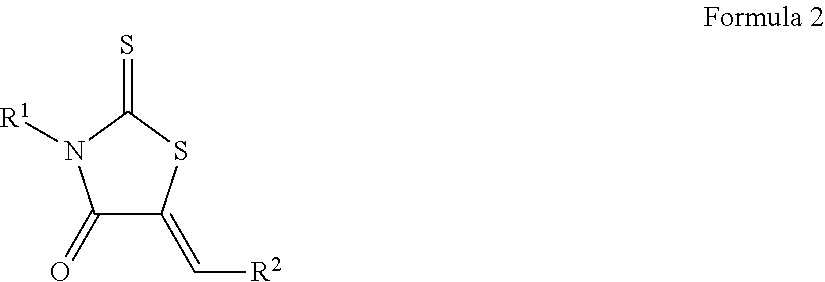Inhibitors of bacterial biofilm formation
a biofilm and inhibitor technology, applied in the field of bacteria biofilms, can solve the problems of increasing the risk of additional patient morbidity and mortality, difficult to eradicate with conventional treatments, and biofilms on biological and inanimate surfaces that are significant medical problems, and achieve the effect of inhibiting or preventing the formation of bacterial biofilms and preventing the formation of biofilms
- Summary
- Abstract
- Description
- Claims
- Application Information
AI Technical Summary
Benefits of technology
Problems solved by technology
Method used
Image
Examples
example 1
Screening for Inhibitors of Staphylococcal Biofilm Formation
[0105]In order to identify small molecule compounds that specifically inhibit staphylococcal biofilm formation, the following screening assay was developed. A higher throughput was achieved by formatting the assay for use in flat-bottomed 96-well assay plates (Costar 3590 assay plates, Corning Life Sciences, Lowell, Mass.). The biofilm cultures grew on the bottoms of each well in a surface attached mode. In each assay plate, columns 1 and 12 contained untreated cultures, which served as negative controls (0% biofilm inhibition). Each of the assay wells in columns 2-11 contained a unique small molecule from the Microbiotix Screening Library (MSL) at a final concentration of 100 μM. Assay plates were inoculated with 200 μl / well of a culture of Staphylococcus pidermidis 18972 in 0.5×Tryptic Soy Broth (TSB; Becton Dickinson, Franklin Lakes, N.J.) in which the concentration of glucose was adjusted to 0.25% (w / v). The bacterial i...
example 2
Characterization of Confirmed Biofilm Inhibitors from Primary Screen
[0110]Confirmed hits from the MSL screening described in Example 1 were evaluated in dose-response assays for anti-biofilm (inhibition of formation) activity, for antibacterial (inhibition of growth) activity, and for cytotoxicity against a human cell line as described below. The data obtained from these assays were used to prioritize compounds for further development and for analyzing structure-activity relationships (SARs).
Minimal Biofilm Inhibitory Concentration (MBIC) and Minimal Inhibitory Concentration (MIC) Secondary Assay.
[0111]A secondary assay provided a quantitative measure of both anti-biofilm activity and antibacterial activity in terms of the Minimal Biofilm Inhibitory Concentration (MBIC) and the Minimal Inhibitory Concentration (MIC), respectively. The MBIC and MIC are defined as the lowest compound concentrations that inhibit biofilm formation and bacterial growth, respectively, by at least 80% (i.e...
example 3
Synthesis of Additional Biofilm Inhibitors
[0117]The results of the library screenings described above led to the design, synthesis, and characterization of additional biofilm inhibitors.
PUM
| Property | Measurement | Unit |
|---|---|---|
| structure | aaaaa | aaaaa |
| antibiotic resistance | aaaaa | aaaaa |
| resistance | aaaaa | aaaaa |
Abstract
Description
Claims
Application Information
 Login to View More
Login to View More - R&D
- Intellectual Property
- Life Sciences
- Materials
- Tech Scout
- Unparalleled Data Quality
- Higher Quality Content
- 60% Fewer Hallucinations
Browse by: Latest US Patents, China's latest patents, Technical Efficacy Thesaurus, Application Domain, Technology Topic, Popular Technical Reports.
© 2025 PatSnap. All rights reserved.Legal|Privacy policy|Modern Slavery Act Transparency Statement|Sitemap|About US| Contact US: help@patsnap.com



